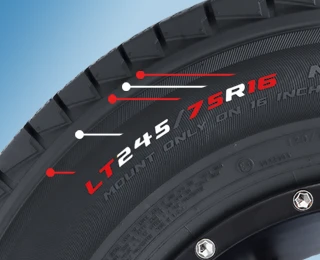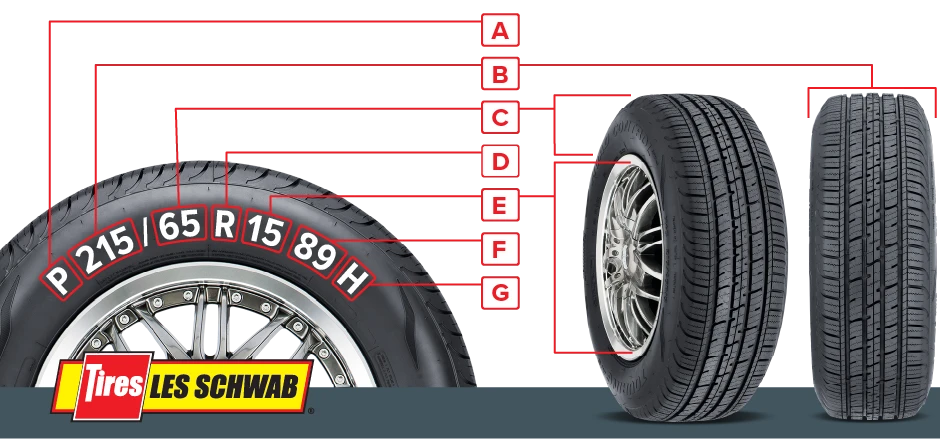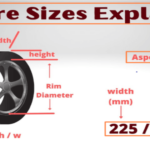Master tire size identification effortlessly with our guide. Quick tips for accurate sizing. Learn how to tell tire size and enhance your driving experience.
Navigating the numbers on your tire’s sidewall is essential when it’s time to replace or upgrade your tires.
Understanding tire size is not just a practical skill but a critical aspect of vehicle maintenance, ensuring safety, performance, and compatibility.
Every tire has a unique code, typically starting with a letter indicating the type, followed by a three-digit number for the width in millimeters, a slash, then a two-digit number representing the aspect ratio.
Next comes a letter for the construction—most commonly “R” for radial—followed by a two-digit number specifying the wheel diameter in inches.
This information allows you to select the correct tires, which is vital for your car’s handling and fuel efficiency.
Keeping these guidelines in mind simplifies the process of reading your tire size and enhances your vehicle care knowledge.
Decoding The Sidewall Code
The numbers and letters on your tire’s sidewall aren’t just random sequences; they’re the key to understanding your tire’s specifications.
Decoding the sidewall code is like reading a secret language that tells you everything about your tire’s size, type, and performance capabilities.
Let’s break down these codes together to ensure you’re fully informed about your tires.
Recognizing Tire Type Prefix
The very first letter you see on your tire’s sidewall indicates the type of tire. Most commonly, you’ll find the following prefixes:
- P means Passenger vehicle tire suitable for cars, minivans, and small SUVs.
- LT stands for Light Truck, ideal for vehicles that tow or carry heavy loads.
- T is for Temporary spare, indicating a tire designed for short-term use.
These prefixes are crucial as they guide the tire’s use and handling characteristics.
Interpreting Width Numbers
Following the tire type prefix is a three-digit number. This number measures the tire’s width from sidewall to sidewall in millimeters.
For example, a code starting with P225 means the tire is designed for passenger vehicles and has a width of 225 millimeters.
Aspect Ratio And Its Importance
The two-digit number after the slash mark in your tire’s code represents the aspect ratio.
This is the height of the tire’s sidewall expressed as a percentage of the tire’s width. A smaller number indicates a lower profile tire. Here’s what it looks like:
- 50 on a tire marked as P225/50 means the tire’s height is 50% of its width.
The aspect ratio is important because it affects driving comfort and the tire’s contact with the road.

Credit: www.instagram.com
Comprehending Load Index And Speed Rating
Understanding your tire’s load index and speed rating is crucial for safety and performance. These numbers give vital information about how much weight tires can handle and at what maximum speed.
Uncover the secrets behind these code-like ratings on your tire’s sidewall.
Load Capacity Understanding
The load index on a tire indicates how much weight each tire can support. A higher number means the tire can carry more weight. To find this rating:
- Locate the tire size specifications on the sidewall.
- Look for a number followed by a letter, e.g., 91V.
- The numeric part is the load index.
Refer to a load index chart to convert this number to actual weight. Each increase in the load index signifies an ability to carry approximately an additional 50 pounds of weight.
| Load Index | Weight Capacity per Tire |
|---|---|
| 85 | 1135 lbs (515 kg) |
| 91 | 1356 lbs (615 kg) |
| 95 | 1521 lbs (690 kg) |
Speed Limitations And Safety
The speed rating is a tire’s certified maximum safe operating speed. It is the letter found at the end of the tire size code. Here’s how to decipher the meaning:
- Identify the letter at the end of the tire’s code.
- Use a speed rating chart to find the corresponding speed.
- Match your tire’s rating to your driving needs.
Speed ratings range from A (the lowest) to Y (the highest). It is essential to never exceed the speed that your tire rating allows. Doing so can result in tire failure, putting you at risk.
| Speed Rating | Maximum Speed |
|---|---|
| T | 118 mph (190 km/h) |
| V | 149 mph (240 km/h) |
| Z | Over 149 mph (240 km/h) |
Where To Find Tire Size Information
Deciphering the code on your tires could seem like cracking an enigma. Yet, it’s a straightforward process once the location of the information is clear.
Knowing how to tell tire size is essential for replacing tires and ensuring safety on the road. The following sections will guide you to where this information hides.
Location On The Tire Sidewall
Your tire’s sidewall holds a wealth of information in a series of letters and numbers. Start by looking directly at the side of the tire.
This code details the tire type, width, aspect ratio, construction, and diameter. For example, P225/65R17 102H indicates a passenger tire of 225 mm width, 65% aspect ratio, radial construction, and suitable for a 17-inch rim.
Vehicle’s Owner Manual Insights
Don’t overlook your vehicle’s owner’s manual. Tucked inside its pages is valuable information specific to your vehicle’s original tire size and specifications.
Flip through the index to find the tire section; every detail needed will be available there.
Sticker In The Driver’s Side Door
If manual searching isn’t your preference, check the driver’s side door. A sticker, often known as the Tire and Loading Information sticker, usually near the door latch.
- Tire dimensions
- Load index
- Speed rating
This sticker confirms the recommended tire size and pressure for optimal vehicle performance.
Comparing Tire Sizes For Upgrade
Getting the right tire size for an upgrade involves more than just picking a set that looks good. The right size impacts the ride, handling, and safety of a vehicle.
Understanding how to compare tire sizes ensures a fit that matches the car’s needs and the driver’s style.
Considering Width And Height Differences
Width and height of tires are crucial when upgrading. These factors affect grip, stability, and aesthetics. Here’s a breakdown:
- Width: More width equals better traction but can also lead to rubbing against the wheel well.
- Height: Taller tires may enhance the look but can alter speedometer readings and clearance.
Choose a size that balances these aspects to maintain a smooth driving experience.
Impact On Vehicle Performance
Upgrading tires is not just about looks; it affects how the car performs. Consider the following impacts:
- Acceleration: Larger tires can slow down a vehicle as they require more power to turn.
- Handling: A change in size could mean a change in how the car handles turns and stops.
- Fuel Economy: Incorrect sizing may lead to increased fuel consumption.
Ensure the new size supports the vehicle’s performance goals.
Ensuring Rim Compatibility
Rims and tires must match for a proper fit. Here’s a mini-guide:
| Rim Diameter | Compatible Tire Size |
|---|---|
| 16 inches | 205/55R16 |
| 17 inches | 215/50R17 |
| 18 inches | 225/45R18 |
Verify the rim’s diameter and choose a tire with a corresponding size.
Online Resources And Tools
Discovering the right tire size for your vehicle is critical for safety and performance. Today, various online resources and tools simplify this task. Let’s explore these helpful tools to ensure you pick the perfect fit for your ride.
Tire Size Calculators
Tire Size Calculators
Use tire size calculators to easily determine the right tires for your car. Just input your car’s details and get results. Here are some benefits:
- Quick and accurate measurements
- User-friendly interfaces
- Free services available online
Don’t guess the size; use these calculators for precision.
Mobile Apps for Tire Measurements
Mobile Apps For Tire Measurements
Smartphone apps bring tire measurements to your fingertips. They offer features like:
- Augmented Reality (AR) visuals
- Save and track tire histories
- Recommendations for tire replacement
Download these apps to make tire assessments effortless and on-the-go.
Forums and Expert Advice
Forums And Expert Advice
Online forums connect you with car enthusiasts and experts. They provide:
- Personalized advice
- Experiences from real car owners
- Guidance from industry professionals
Engage in forums to gain insight and reliable information on tire sizes.

Credit: www.lesschwab.com
Professional Assistance And Services
Finding the right tire size can be tricky. But worry not! Tire specialists are here to help. They offer in-depth knowledge and services, making your experience seamless.
Trust them to guide you through the complexities of tire sizing.
Visiting A Tire Specialist
Visiting a tire specialist is the first step toward accurate tire sizing. These experts use advanced tools to determine the perfect fit for your vehicle.
Their experience ensures a precise and efficient assessment of your tire needs.
Benefits Of In-store Tire Consultation
In-store consultations come with benefits:
- Personal Service: Specialists cater to your specific vehicle needs.
- Instant Answers: Get immediate insights into the compatible tire sizes.
- Physical Inspection: They check your vehicle for the best tire fit.
- Safety Assurance: Experts recommend the safest options available.

Credit: www.instagram.com
Frequently Asked Questions Of How To Tell Tire Size
What Do The 3 Numbers Mean On Tire Size?
The 3 numbers on tire size indicate width, aspect ratio, and diameter. Width is in millimeters, aspect ratio is the height to width percentage, and diameter is the wheel size in inches.
How Do You Read Tire Size For Dummies?
To read tire size, check the sidewall for a code like “P215/65R15. ” “P” stands for passenger vehicle, “215” is the width in millimeters, “65” is the aspect ratio, “R” indicates a radial construction, and “15” represents the wheel diameter in inches.
How Do I Know My Tyre Size?
To find your tyre size, check the sidewall of your tire. It displays a series of numbers and letters, such as “255/55R18,” indicating the tyre’s width, aspect ratio, and diameter.
How Do You Measure Actual Tire Size?
To measure tire size, refer to the sidewall markings for width, aspect ratio, and diameter, or use a tape measure for the tire’s width and diameter directly.
Conclusion
Determining your tire size is essential for both safety and performance. With the methods outlined, you can confidently find this information.
Remember, the sidewall code is your go-to resource. Keep this guide handy to ensure proper tire selection and replacement, securing a smooth ride ahead.

Sudatta is a passionate automotive enthusiast and expert in the field. With a keen eye for detail and a love for all things automotive, he shares insightful articles and reviews to ignite the automotive passion in readers.




